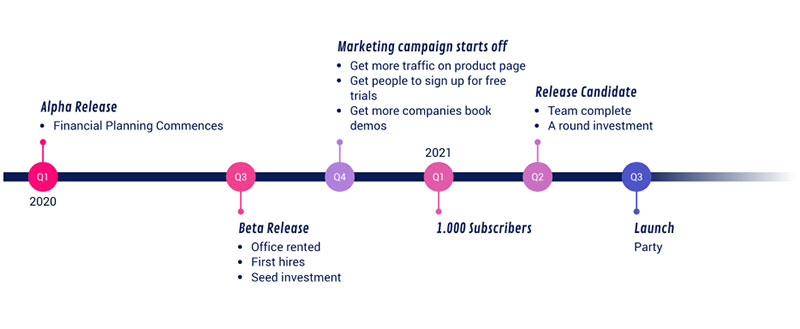Embarking on the journey of creating software is akin to building a house; without a blueprint, the process can become a labyrinth of confusion. Let’s face it, a software development plan is your compass in the digital wilderness. It delineates the terrain, plotting a course from nebulous ideas to polished, functional software.
In this realm, precision is paramount. Lacking a detailed itinerary can send resources spiraling and timelines into chaos. You’re craving a master plan, and that’s precisely the treasure map we’re about to unfold.
Within these lines, you’ll unearth the bedrock principles of project timelines, requirement analysis, and the venerated Agile methodology.
By article’s end, anticipate having your own quiver of strategies – from code repositories to testing strategies – ready to launch any software venture.
Delve into the architecture of a plan that champions quality assurance and steers clear of technical debt. Master the art of sprint planning and evolve beyond bug tracking to a symphony of deployment schedules that resonate success.
We’re not just building software; we’re crafting legacies in code. Join me, and harness the power of a plan that propels visions into reality.
What a Software Development Plan Is
Every software development project, whether following the Waterfall model or Scrum methodology, has some features in common.
The process starts with conceiving an idea. Next comes its design, realization, and programming, all crucial in the development lifecycle.
It should also encompass the later parts of the application’s life cycle, including software maintenance and user acceptance testing (UAT).
In its simplest form, a software development plan is a timeline of the project. It showcases the scheduling for each phase, indicating when it starts and when it concludes. This planning aids in task tracking and sprint planning.
Zooming in on a phase reveals the different substeps, code reviews, and integration testing that it entails.
A software development plan communicates the approach that the project will undertake, the required product roadmap software tools and platforms, and the needed resources. This clarity is vital for the project team members, as well as clients and other stakeholders. You can use a flipbook software to document your plan, capturing elements like technical specifications and presenting it in an interactive way, so your team and clients can effortlessly grasp it.
The development plan answers the following questions:
- What problems does the software project aim to address and solve?
- What are the main tasks and feature prioritization?
- What are the resources, source code management, and version control mechanisms that the project involves?
- When during the project are the resources and code repository needed?
- Which is the functionality chosen to address the problem?
- What is the estimated time to complete the project/sprints?
- What are the milestones, deadlines, deliverables, dependencies, and change requests?
- Who are the ones involved in the project?
- What are the responsibilities of each team member and their role in system integration?
- How is the quality measured? What are the quality metrics and quality assurance procedures?
There are various elements that managers may incorporate in the software management plan. These essentials include:
- The expected outputs of the software, emphasizing its software architecture.
The functionality details might remain undefined at this juncture. However, the plan should document the outputs and their relevance in the project scope.
- Who will release the software? This could be the principal investigator, project manager, lead developer, or someone responsible for continuous integration/continuous deployment (CI/CD).
- The revision management procedure, which encompasses the software development process and its iterations.
- The license for each output, ensuring proper software maintenance.
Want to give your career a chance? Check out this course from IBM.
The Full-Stack Cloud Native Application Developer Professional Certificate program by IBM is an excellent opportunity for anyone interested in starting a career in software development.
With 10 courses covering a wide range of technologies and tools, you’ll gain practical skills and knowledge, work on hands-on projects, and build a portfolio of applications that you can deploy on a cloud platform using Cloud Native methodologies. No prior experience is necessary, and you can earn college credits upon completion.
How to Write a Software Development Plan
To construct an effective software development plan, it’s vital to understand its importance and how it fits into the broader software design and architecture landscape.
Below are the most common phases of a software development project, often seen in both Agile development and the Waterfall model. Use them as a guide when detailing the phases and elements of any project.
Analysis and Planning
After a client puts in a request for the development of software, the management team, including those familiar with project management and Scrum methodology, sits down to plan. These are some important elements to consider:
- Alignment. How does this project fit in with the company’s mission, goals, and overall software requirements specification?
- Resources. Does the company have the human, software tools, and platforms to achieve project success?
- Scheduling. How does this project align with the development lifecycle, timelines of other projects, and goals?
- Cost and Budget estimation. How much will it cost? And is it aligned with the project’s resource allocation?
Get all the involved departments together, ensuring task tracking and sprint planning. This includes developers, project managers, security, quality assurance teams, and other stakeholders. Using a product planning software tool is an excellent way to manage all this, ensuring adherence to coding standards and maintaining a clear documentation.
Define The Goals
When defining the goals of the project, specify intentions, visions, and preferred endpoint. Such clarity makes it easier to predict the outcome of the project, both for the client and the company. This definition stage is crucial for setting a proper project scope. Something that is often overlooked leading to project scope creep, a major project plan risk that could have been easily avoided.
Defining the goals is also essential to write a realistic, concise project plan that accounts for software maintenance and user acceptance testing (UAT) phases.
Software should automate certain tasks, boost productivity, streamline processes, and align with the chosen functionality to address problems. The exact goal and how it fits into the development phases should be clear.
With that in mind, define how to quantify the success of the project, considering milestones, deadlines, and deliverables. Many managers make use of a Gantt chart or even source code management tools to visualize and track this part.
Create a Team

Often, software development is teamwork and plays a pivotal role in the software development lifecycle.
Teams consist of various individuals. Each one brings their specific skills, software tools, and expertise to the table in line with the coding standards.
That is crucial because a project, especially one under a Scrum methodology or Waterfall model, consists of different aspects. Selecting the right people for your dev team contributes to the project’s alignment with the software requirements specification and ultimately to its success.
Some software development project teams, aiming for agile project management, are further divided into several smaller teams. Each sub-team then has its unique focus on specific development phases.
This structure can help to amplify individual skills and strengths, ensuring better task tracking and sprint planning.
In some scenarios, there’s a need to outsource certain tasks, especially when the company lacks staff with specific skill sets or tools for system integration.
Some companies employ external entities and utilize CRM for recruiting and assembling a team that respects software architecture principles.
Given the number of people and departments involved, it becomes paramount to have one person that determines the direction. There should be a senior project manager, experienced in project scope definition, as the ultimate decision-maker.
This individual should possess both skill and experience in planning, quality assurance, and executing a software project.
Resources and Requirements
With the goals defined in line with the software’s functionality, teams can discern what resources they require to achieve the desired outcome. When enumerating the needed resources, ponder over these elements:
- Resources, including software maintenance tools
- Budget and resource allocation
- Time and timeline of the project
Each factor is quintessential to undertake the tasks needed to achieve the set objectives. The resources will vary for each software development project plan, considering its technical specifications.
This differentiation is contingent on the project’s idea, size, and its software design. The resource’s availability defines the timeline, milestones, deliverables, and dependencies.
Yet, this section goes beyond just itemizing resources. It aids developers in understanding the needs and goals of the software development process and adhering to the software development lifecycle.
The list’s length will rely on the software project and its project management intricacies.
Numerous factors come into play. These encompass the project’s scale and the precision of the initial requirements and goals, reflecting on version control and source code management.
Colossal projects, often involving myriad stakeholders or expansive objectives within an Agile development framework, might undergo goal evolution. In such scenarios, objectives can morph unexpectedly.
Therefore, allow for flexibility in project scope. This adaptability ensures any abrupt changes are accommodated, ensuring targets remain achievable.
A competent project manager, skilled in software design, can articulate in detail the prerequisites of the software development process.
Constraints and Risks

Now, the clients, developers, stakeholders, and other parties involved in the software development lifecycle can identify potential problems. Especially challenges that might decelerate or halt the software design and execution process.
These issues can be categorized by production stages, such as development, system integration, or product launch. Additionally, it’s prudent to account for unforeseen circumstances and development phases.
Many software development teams, aligned with coding standards, utilize a risk matrix to spot possible issues. This tool illustrates the probability of the issue arising and forecasts its repercussions.
Other terms often used in this context include chance, risk extent, and severity, reflecting the project’s software requirements specification.
From a managerial perspective, it’s essential to weigh both the technical and business risks. These elements are crucial in the overarching software development plan.
Potential challenges could encompass:
- Software maintenance support from management
- Adherence to the appropriate project scope and timeline
- Allocating a suitable budget in sync with the software architecture
- Availability of skilled software developers familiar with Scrum methodology and Waterfall model.
Map the Business Processes
Scrutinize the routines of lower-tier employees, taking into account their software tools and methods. Understand their modus operandi and the resources they employ for tasks.
Translate these actions into a flow diagram, echoing the project management strategy.
There isn’t a single, universally accepted approach to mapping business processes. Indeed, several robust methodologies, aligned with software design, exist.
One renowned strategy is the Agile Methodology, emphasizing short sprints, milestones, and deliverables to amplify progress.
Consulting senior management can offer solutions to bottlenecks, but engaging floor-level staff might provide a fresh, ground-up perspective.
The organization’s size will influence the number and selection of participants in this software development process.
Budget Estimation
Undoubtedly, this segment is pivotal. Every action tethered to a software development project incurs expenses, tied to the software’s functionality and technical specifications.
That’s why it’s paramount to outline plans, prerequisites, and targets upfront. Such foresight aids in estimating the cumulative project expenditure, considering quality assurance needs.
Striking a harmonious balance between budget and quality, aligned with the project’s scope, is essential.
Hence, to optimize cost-efficiency, numerous businesses are now gravitating towards offshoring their development tasks. They’ve discerned it’s more economical than in-house operations, especially when factoring in resource allocation and version control.
Create a Timeline

A software development plan sets out a rough definition of the project phases at an early stage. The timeline, which is integral to the software development lifecycle (SDLC), gives a detailed plan of the needed steps and their deadlines.
This is the moment to divide project goals into manageable tasks. Before starting a task, the requirements gathering phase ensures that it is not always 100% clear how to accomplish it completely.
Still, take time to list whatever needs to be done and use as much documentation and detail as possible. That will make the software design and architecture clearer too.
With a tasks list and an overview of the budget and human resources, it is possible to estimate the time needed.
The milestones, much like checkpoints in an agile methodology, are an important part of the timeline. It accounts for the work schedules and justifies the resources the project will use within the development environment.
The problem with software development projects is the risk and uncertainty they bring, closely tied with risk assessment.
It is thus wise to calculate some buffer time and also have a plan for continuous integration to complete all tasks. Also, the services of a project manager and project management tools ensure that the project stays on track and aligns with the development cycle.
Sprint Meetings
Sprints and sprint meetings are part of modern management techniques. These techniques, often seen in Scrum framework and other development methodologies, aim to minimize project time frames.
During sprint meetings, managers, developers, and others involved in the project get together in a Scrum environment. They will discuss what tasks are on the product backlog for that week, and how it aligns with the software milestones.
Some managers prefer to have sprint meetings every two weeks, or even once a month. Any way works but needs to be in agreement with the project demands and expectations. You can also use sprint planning tools to make the whole process easier, ensuring the tasks align with the development timeline.
A task defines a sprint, and each developer or team member has a specific task. The skill and user stories experience of the team member determine the nature of the task.
It is up to the project leader or manager to determine which task to assign to which developer within the iterative development process.
Continuous Revision and Modification

Testing, quality assurance, tracking, and bug fixing run parallel with the software development process. This is an ongoing process that aims to remove as many problems as possible and move the project forward, closely following the development roadmap.
After the completion of the software comes another round of in-depth testing. Usually, a group of beta testers does this.
User experience tools can show how users interact with the software in the user acceptance testing (UAT) phase.
Even after the software’s release, with the support of deployment strategy, it is good for developers to look back at their work. Software development is a very dynamic and fast-moving field, evolving with new software tools and techniques.
So, keeping older versions in a version control system like Git is very important.
If disputes arise during development, older versions in the code repository are useful to refer back to. Color coding and using systematic code review processes are good ways of keeping track of different versions.
Risks Associated With Software Development Planning
Writing up a good software development project plan is not simple. When a software project, or any part of the software development lifecycle (SDLC), increases in complexity, the requirements gathering and planning become even more challenging.
The reason software projects fail is often found in poor project management and planning. The following section gives specific reasons why some software development project plans fail and the importance of a development roadmap.
Unclear Goals
Success in any development cycle is only measurable when there are clear goals. In other words, it is not possible to achieve success if success is only a vague idea in the software design.
Poorly defined goals can ruin an entire project, causing a misalignment in the software architecture.
A project may start out with a certain focus but ends up in a very different place within its development timeline. There is a product, but it does not meet the aim of the project or its milestones.
Those kinds of projects are impossible to keep on track because they have no clear goal.
So at the start of a project, during the Scrum framework or planning phase, take time to understand the problem at hand. Consider how to measure success and set relevant software milestones.
Plans Address the Wrong Needs
Software development projects are very dynamic and are subject to constant change, much like in an iterative development process.
At the beginning that is because project specifics are not developed in full detail. But also, as the development environment evolves, during the process changes occur.
Teams and stakeholders change their opinions over time. A software development plan must be flexible and written with the latest needs in mind, considering the project’s version control and evolution.
Inadequate Documentation
Agility, often associated with Agile methodology, is good, but disciplined documentation, which includes technical specifications, is just as important. Starting with the planning phase, write down agreements, timelines, aspects, and project milestones.
Include Acceptance Criteria and User Stories. These help developers to grasp what the problem is and what kind of work it involves, ensuring alignment with the project roadmap.
That will result in a product tailored to the needs of the client and the user acceptance testing (UAT) phase.
Communication Gaps
As in all projects, communication, especially during sprint planning, is of vital importance. User research and direct communication are two tools that can help with this process, ensuring alignment with the product backlog.
They help to define the user audience and adjust the product to their needs. Omitting them, as well as user validation, could result in an irrelevant product that doesn’t align with the Scrum framework.
Don’t forget any external teams or stakeholder feedback involved with the project. They too will appreciate and benefit from close communication.
No Leadership or Accountability
Some companies leave the entire software development process, including system integration and deployment strategy, to the IT department. Managers and other executives push away all responsibility in some cases.
This puts the software development plan into the hands of people whose strengths may lay in different areas, leading to a potential misalignment in software tools and techniques. It results in a lack of direction.
This will likely lead to the failure of any software development process. Afterward, no one wants to take responsibility for them, causing issues in resource allocation and project management.
Scope Creep
If goals, especially within the software design, are not defined and documented in the software development lifecycle (SDLC), this may have very large negative effects later on, impacting the overall development roadmap.
Individual sprint goals, as part of the Scrum framework, may be hard to achieve. The result is a delay in feedback and meeting development milestones and deadlines.
Building agility into a software development plan, especially with the influence of Agile methodology, makes the project easier to manage. There will always be changes in the project, just like in iterative development, and agility helps to deal with these adjustments and changes in the software architecture.
There is an easy way to include flexibility in any software development plan. Break down a large complex project into small achievable software milestones, maintaining a strong development timeline.
Lack of a Data Protection Plan
Software development involves complex IT infrastructures with a lot of data generated, processed, and stored, touching upon aspects of software tools and version control.
Losing that data or inaccessibility to that data for long periods of time due to a natural disaster, ransomware attack, or any other reason would disrupt development, affecting the project management and might even make finishing the project, including system integration, impossible.
Organizations should set up data protection workflows to make their environments and critical data more resilient. Specialized solutions, such as VMware backup from NAKIVO, can help in organizing and managing automated backup, retention, and recovery workflows from one dashboard to save time and resources, ensuring the project’s development environment is secure.
Lack of User Testing and Feedback
Most software is for human use. It is important to keep that fact in mind, especially when considering user acceptance testing (UAT) and product backlog.
If most humans find it difficult or unpleasant to work with, it is likely that in the end, no one will use it, despite having followed the Scrum framework and achieving all software milestones. That would be a waste of all the invested time, resource allocation, and money.
FAQ On Software Development Plan
What Exactly Is a Software Development Plan?
Picture a roadmap; that’s your software development plan. It charts out every phase, from ideation through deployment, ensuring project timelines stay tight and risk management isn’t an afterthought.
A solid plan touches on resources, milestones, and offers a testing strategy to iron out kinks pre-launch.
Why Is a Software Development Plan Critical?
Well, without one, you’re flying blind. It anchors your Agile methodology in place, aligns your team on the development framework, and sets expectations on delivery. It’s like the conductor of an orchestra – keeps every musician, or in this case, developer, in sync.
What Steps Are Included in Creating a Software Development Plan?
Think of it as crafting a recipe. Begin with requirements analysis, add a dash of system architecture design, a sprinkle of module design, then mix in consistent sprint planning. Don’t forget to garnish with a rigorous testing strategy for that perfect dish.
How Detailed Should a Software Development Plan Be?
Goldilocks has the answer: not too vague, not an epic novel – just right. Details like programming languages, software prototypes, and technical specifications should be clear. Meanwhile, allow some breathing room for adaptability and technical debt management. A good plan evolves.
How Does Agile Methodology Influence a Software Development Plan?
Agile is all about flexibility, baby. Traditional plans are static, but with Agile, your plan turns dynamic – think living document. It encourages adjustments post-feedback, continuous improvements during those fun sprint retrospectives, and prescribes regular check-ins through daily scrums or meetings.
Who Is Responsible for the Software Development Plan?
Zoom in on the maestro – the project manager or software architect, depending on size and complexity. They pull the strings, ensuring harmony between the plan and the software development life cycle (SDLC). Plus, input from the key players, like developers, designers, is pure gold.
Can the Plan Change During the Development Process?
Absolutely. Pivoting is part of the game. Market swings, customer feedback, or a revamped feature roadmap could necessitate tweaks to your plan. Just ensure those changes get documented and communicated faster than a high-speed internet connection. Stay nimble, stay smart.
How Often Should a Development Team Refer to the Plan?
Consistently, like clockwork. It’s your tale of project milestones and goals. Morning coffee, team huddle, flip open that plan. Revise as you hit those sprint goals or face unexpected hurdles. Think of it as the beating heart of your project’s quality assurance.
How Does a Software Development Plan Impact Stakeholders?
It’s the crystal ball for stakeholders. Gives them a sneak-peek into progress, costs, and those exciting feature roadmaps. Trust me, stakeholders treasure transparency like a rare diamond, and an updated plan reflects a shimmering image of project health and future prospects.
What Are the Risks of Not Having a Software Development Plan?
Roll the dice, and you might land a critical bug or slip deadlines like a pro ice skater. No plan? Prepare for resource drain, cost overruns, and a probable frowning user acceptance testing (UAT) outcome. Chaotic creativity needs structure to transform into lucrative success.
Conclusion
And there you have it— we’ve reached the finish line of our software development plan odyssey. The insights tucked in these paragraphs are your golden tickets to navigating the often stormy seas of software creation.
Remember, a plan isn’t just a document; it’s a lighthouse guiding your sprints, user stories, and coding sessions. It embodies the Agile spirit and stands resilient to the whims of project tides.
Sure, software crafting is no cakewalk. But with a robust plan in your arsenal, quality assurance isn’t a roll of the dice—it’s a surefire bet. Keep the plan close, like a trusty Swiss Army knife. Whether you’re knee-deep in code or at the helm strategizing over the system architecture, let it be the soundtrack you orchestrate each keystroke to.
So, armed with this knowledge, step forth and sculpt digital marvels. May your software development plans be the blueprints of countless successful launches.
If you enjoyed reading this article on creating a software development plan, you should check out this one on the 7 phases of SDLC.
We also wrote about a few related subjects like risk assessment matrix, business pivot examples, in-house development vs outsourcing, financial software development companies, why is refactoring your code important, startup consultants, apps to make apps, IT outsourcing failures, software development principles, and software development outsourcing trends.
- Quick Guide For Developing Mobile Games - April 18, 2024
- Free Streaming Heaven: Top Apps Like Tubi - April 18, 2024
- Crafting the Perfect Pitch to Secure Investors for Your Mobile App - April 18, 2024









